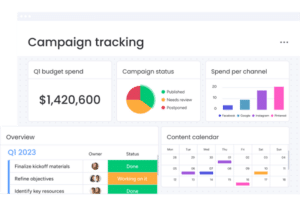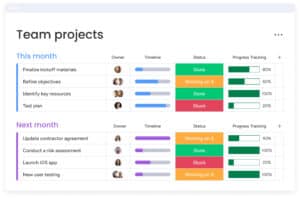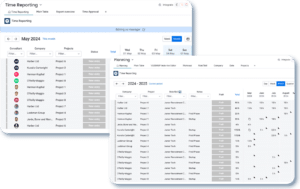Every business striving to make a mark in today’s hyper-competitive landscape understands the importance of an effective marketing strategy. For B2B companies, however, the task is often more complex, fraught with unique challenges and a myriad of considerations. Hence, streamlining a B2B marketing strategy is a whole other ball game.
The Necessity for B2B Marketing Optimization
B2B marketing isn’t just about selling a product or a service; it involves nurturing relationships, understanding intricate market dynamics, and often, making sense of large and complex decision-making units. With the right approach, these challenges can be transformed into opportunities, and this is where streamlining your B2B marketing efforts comes into play.
The process of streamlining isn’t about cutting corners or taking the easy route. Rather, it’s about refining your marketing strategy to ensure that every effort, every campaign, and every piece of content serves a clear purpose and moves you closer to your business goals.
Setting the Stage
In this blog post, we’ll delve into the concept of streamlining B2B marketing efforts, offering insights into the complexities of the landscape and sharing actionable steps to help you simplify your approach and fast-track your journey to success. Whether you’re a seasoned marketer looking to optimize your strategies or a newcomer to the B2B world, the insights within these pages will offer a fresh perspective and a roadmap to an efficient, effective, and successful marketing strategy.
Understanding B2B Marketing Complexity
Navigating the terrain of B2B marketing can often feel like a labyrinth of challenges. Let’s break down these complexities and understand their sources.
Unpacking the B2B Landscape
Unlike B2C, B2B marketing involves transactions not between businesses and individual consumers, but between two corporate entities. This shift in dynamics brings with it a slew of factors that complicate the marketing process. Decision-making in B2B scenarios often involves multiple stakeholders, each with their own needs, preferences, and opinions. Consequently, the sales cycles are often longer, and the emphasis on relationships and trust is far greater.
Moreover, B2B products or services can often be intricate, requiring thorough explanations, demonstrations, or even customized solutions. The stakes are usually high, with large sums of money on the line and the potential for long-term business relationships hanging in the balance.
Challenges in B2B Marketing
In B2B marketing, the complexity multiplies. Marketers must balance a multitude of tasks – identifying the right decision-makers, crafting personalized messages, managing long sales cycles, demonstrating clear ROI, and staying ahead of fierce competition. Additionally, the landscape is constantly changing, with new technologies, shifting customer expectations, and evolving business models adding further layers of complexity.
In the face of such challenges, it’s easy to see how a B2B marketing strategy can quickly become convoluted. Without a clear roadmap, marketers risk losing sight of their goals, spreading their efforts too thinly, or missing crucial opportunities. This is why streamlining your B2B marketing efforts is not just an option, but a necessity.
In the next sections, we’ll delve into the components of B2B marketing strategy and how they can be streamlined for maximum impact and efficiency.
Key Components of B2B Marketing Strategy
Before we can streamline our marketing efforts, we must first understand the moving parts of a B2B marketing strategy. These foundational elements form the structure upon which a successful B2B marketing strategy is built.
Identifying Key Components
The heart of any B2B marketing strategy revolves around these critical components:
- Target Market Identification: Understanding who your buyers are is the first step. This involves identifying industries, companies, and individual decision-makers that would find the most value in your product or service.
- Value Proposition: This outlines what sets your product or service apart from competitors. A well-crafted value proposition addresses the needs of your target market and highlights the unique benefits you provide.
- Marketing Channels: The platforms and methods you use to reach your target audience – be it social media, email marketing, content marketing, SEO, paid advertising, or events – form a crucial part of your strategy.
- Content Strategy: This includes the creation and distribution of valuable, relevant, and consistent content aimed at attracting and retaining a clearly-defined audience — ultimately driving profitable customer action.
- Lead Generation and Nurturing: This involves attracting potential buyers (leads) and nurturing them through the sales funnel, providing them with the information and incentives they need to become customers.
- Measurement and Analysis: Regularly analyzing your marketing efforts and adjusting your strategy based on data is key to maintaining effectiveness and proving ROI.
Potential Complexities in B2B Marketing
Each of these components, while necessary, has the potential to add complexity to your B2B marketing strategy. The more target markets you have, the more customized your value propositions need to be. The more channels you use, the more content you need to create. And the more leads you generate, the more data you have to analyze.
The challenge lies not in eliminating these complexities but in managing them effectively. The following sections will provide you with practical steps to streamline your B2B marketing strategy, making it more efficient, effective, and results-driven.

The Art of Streamlining Your B2B Marketing Strategy
Streamlining your B2B marketing is about more than merely trimming down your efforts; it’s about making each aspect of your strategy more purposeful and effective. Let’s take a deeper look at how you can streamline your B2B marketing approach.
The Importance of Clear Goals
Every marketing effort should begin with a clear objective. What are you aiming to achieve? It could be increasing brand awareness, driving more leads, improving lead conversion rates, or boosting customer retention. Your goals should be specific, measurable, attainable, relevant, and time-bound (SMART). With clear goals in place, it becomes easier to align your marketing efforts and measure your success.
Adopting a Customer-centric Approach
A streamlined marketing strategy is one that revolves around the customer. This means going beyond demographic information and understanding the needs, challenges, and goals of your B2B customers. When you truly understand your customers, you can create more targeted and relevant marketing messages, saving time and resources in the process.
Focusing on High-Impact Channels
Not all marketing channels are created equal. While it may be tempting to be present everywhere, it’s more effective to identify and focus on the channels that deliver the most impact. This could be a particular social media platform, email marketing, content marketing, or SEO. By focusing your efforts on these high-impact channels, you can get more results with less effort.
The Role of Integration and Automation
In the age of digital transformation, technology plays a critical role in streamlining marketing efforts. The right tools can remove redundancies, increase efficiency, and ensure a consistent marketing approach. Two such tools that are particularly helpful in streamlining B2B marketing efforts are monday.com and Make.
monday.com is a flexible platform that helps teams manage their work. Its intuitive interface and robust features make it an excellent tool for managing marketing projects. With monday.com, you can keep track of campaign progress, assign tasks, set deadlines, and collaborate effectively with your team. Furthermore, the platform’s integration capabilities allow you to connect your marketing efforts with other business operations for a seamless workflow.
On the other hand, Make is an advanced online automation platform that allows you to automate manual processes that consume your time. For instance, you can manage integrations with your email tools and CRM system to automate certain cadences based on where your prospects/clients are in the sales cycle. It also provides visual representations of your workflows, making it easier to understand and manage your automation. Make can also be used as an enhancer of monday.com. Because of its integrating capabilities, you can transform monday.com into a full-blown marketing tool that replaces other common tools such as Hootsuite, Sprout, HubSpot, etc. Make also enables you to integrate Open AI with monday.com, further streamlining your strategy with more effective content creation.
By integrating your tools and automating repetitive tasks, you not only save time but also reduce the risk of errors, ensuring that your marketing machine runs smoothly and consistently. It’s an investment that pays for itself in increased productivity and efficiency.
The Power of Data-Driven Decision Making
Data should be at the heart of your B2B marketing strategy. By measuring and analyzing your marketing performance, you can identify what’s working and what’s not. This enables you to continuously optimize your strategy and allocate your resources more effectively.
In the next section, we’ll provide practical steps to apply these principles to the key components of your B2B marketing strategy.
Practical Steps to Streamlining Your B2B Marketing Strategy
After gaining a deeper understanding of what streamlining your B2B marketing entails, it’s time to translate these concepts into practical steps. Here, we’ll walk you through actionable strategies for each of the key components of your marketing strategy.
Streamlining Your Target Market Identification
One of the first steps to streamlining your marketing efforts is refining your target market identification. By focusing on a narrower, well-defined market, your marketing messages can become more targeted, saving time and resources. Use detailed buyer personas and market segmentation to understand your audience’s needs, preferences, and behaviors. Use these insights to guide your marketing strategy.
Refining Your Value Proposition
A streamlined value proposition cuts through the noise and communicates your unique value clearly and concisely. Focus on the benefits that are most relevant to your target market. Make sure your value proposition is easily understood and can be communicated consistently across all marketing channels.
Optimizing Your Marketing Channels
Focus on the channels that deliver the best results for your business. You don’t need to be everywhere; instead, choose the platforms where your target audience is most active and engaged. Regularly evaluate the performance of these channels and adjust your strategy as needed.
Enhancing Your Content Strategy
Streamline your content creation by establishing a content calendar and sticking to it. Use your buyer personas to guide your content topics, and focus on creating high-quality content that addresses your audience’s needs and questions. Repurpose content across multiple channels to maximize your efforts.
Automating Lead Generation and Nurturing
Automating lead generation and nurturing can significantly streamline your marketing efforts. Use tools like monday.com to manage your lead data, and platforms like Make for automating workflows like sending personalized follow-up emails or updating lead scores.
Embracing Measurement and Analysis
Use data analytics to monitor your marketing performance regularly. Identify key metrics that align with your marketing goals, and use them to measure your success. Use these insights to continuously refine your strategy, focusing on the tactics that deliver the best ROI.
By following these practical steps, you’ll be well on your way to a more streamlined, efficient, and effective B2B marketing strategy. In the next section, we’ll discuss the potential impact of these efforts on your business.

The Impact of Streamlining Your B2B Marketing Strategy
Once your streamlined B2B marketing strategy is in place, the positive effects will ripple through various aspects of your business. But what can you expect to see? Here, we outline the potential impact of a streamlined approach.
Increased Marketing Efficiency
First and foremost, a streamlined marketing strategy results in improved efficiency. By focusing on high-impact activities, reducing unnecessary complexity, and automating routine tasks, your marketing team can accomplish more in less time. This not only saves time and resources but also enables your team to focus on more strategic, high-value tasks.
Improved Marketing Effectiveness
By refining your target market, enhancing your value proposition, and focusing on the most impactful channels and content, your marketing messages will resonate more powerfully with your audience. This targeted approach can lead to improved lead generation, higher conversion rates, and ultimately, increased revenue.
Enhanced Customer Experience
A streamlined B2B marketing strategy also enhances the customer experience. With a customer-centric approach and integrated marketing tools, you can create a seamless customer journey, from awareness and consideration to decision and advocacy. This improved customer experience can lead to stronger relationships, improved customer loyalty, and increased customer lifetime value.
Better Decision Making
With a data-driven approach, you’ll have a clearer view of your marketing performance. This allows for more informed decision-making, enabling you to continuously optimize your strategy and allocate your resources for the highest return on investment.
In summary, a streamlined B2B marketing strategy not only improves your marketing outcomes but also creates a positive feedback loop. Improved efficiency leads to better results, which in turn provides valuable data to further optimize your strategy. The next section will wrap up our discussion and leave you with some final thoughts on streamlining your B2B marketing efforts.
Conclusion
As we wrap up our exploration of streamlining your B2B marketing strategy, it’s important to remember that the journey towards optimization is ongoing and iterative.
Streamlining: A Continuous Process
Streamlining isn’t a one-and-done endeavor but a continuous process of refinement and improvement. The business landscape is dynamic, with new technologies, market trends, and customer expectations constantly emerging. To stay ahead, your marketing strategy must be adaptable and forward-thinking.
Embracing the Streamlined Approach
While the task of streamlining your B2B marketing strategy may initially seem daunting, the benefits are well worth the effort. By embracing a streamlined approach, you can navigate the complexities of B2B marketing with greater ease, improve your marketing efficiency and effectiveness, enhance the customer experience, and make better, data-driven decisions.
Getting Started with Streamlining Your B2B Marketing Strategy: Integration and Automation
One of the best ways to kickstart your efforts in streamlining your B2B marketing strategy is by focusing on integration and automation. These aspects not only save time and reduce errors but also help you get a better overview of your marketing efforts.
The Power of monday.com and Make
Key players in this landscape include platforms like monday.com and Make. monday.com offers a powerful platform to manage all your marketing projects, tasks, and communication, while Make can automate all your routine tasks, leaving you free to focus on strategic marketing efforts. Together, they form a powerful duo that can transform the way you handle B2B marketing. They make your processes much more efficient and effective with automations and integrations, uniting all your work in one platform.
How Omnitas Consulting Can Help
As an experienced partner of both monday.com and Make, Omnitas Consulting is uniquely positioned to assist your organization with the implementation of these tools. Our team of experts can guide you through the entire transformation process, ensuring that the tools are configured to suit your specific needs and that all integrations work correctly.
We understand that change can be challenging, and that’s why we also focus on making the transformation into the new tools go as smoothly as possible. We do this by providing support and training to your team, ensuring that they are comfortable using these new tools and can leverage them to their full potential.
Beyond the initial implementation, we continue to provide ongoing support, ensuring your systems evolve along with your business needs. This way, you can focus on what you do best – driving growth for your business – while we take care of your technology needs. In case it’s needed, we also offer custom projects for situations where bigger implementations and integrations need to be made. Our implementation team is here to make the process as smooth as possible while creating a solution tailored to your business needs.
By partnering with us, you’ll have the reassurance of expert support and guidance throughout the whole process. Reach out to us now and let’s get started on your journey toward a more streamlined B2B marketing strategy!
























